Malaysian-Japanese joint-venture to invest $308 million in 100,000ha plantation for biodiesel, biogas in Sarawak
 Malaysia's state news agency Bernama reports that Carbon Capital Corporation Sdn Bhd will join hands with Japan Carbon Mercantile Co. Ltd to develop a multi-feedstock biodiesel plant in Tanjung Manis in Sarawak, as part of a major, US$100 billion energy and infrastructure development program for the state that aims to churn out 20GW of low carbon power by 2030. The plant will utilize jatropha curcas and palm oil for biodiesel and power production. The crops are to be established on 100,000 hectares of plantations. Besides biodiesel, a biogas plant will be build to utilize waste streams from the crop processing operations.
Malaysia's state news agency Bernama reports that Carbon Capital Corporation Sdn Bhd will join hands with Japan Carbon Mercantile Co. Ltd to develop a multi-feedstock biodiesel plant in Tanjung Manis in Sarawak, as part of a major, US$100 billion energy and infrastructure development program for the state that aims to churn out 20GW of low carbon power by 2030. The plant will utilize jatropha curcas and palm oil for biodiesel and power production. The crops are to be established on 100,000 hectares of plantations. Besides biodiesel, a biogas plant will be build to utilize waste streams from the crop processing operations.The project was announced at the launch of the "Sarawak Corridor of Renewable Energy" (SCORE) in Bintulu yesterday, which saw commitments for investments totalling RM 500 billion (€105.7/US$154.3bn). Prime Minister Datuk Seri Abdullah Ahmad Badawi said the proposed investments - amongst them commitments by mining giant Rio Tinto - were made in 24 memoranda of understanding (MOUs) signed during the launch.
SCORE is a large development project supposed to help reduce poverty and improve income distribution among the people in Sarawak by stimulating economic development in key sectors. It would add value to existing heavy industries, focus on development of natural resource-based industries (see overview below) and emphasise research and development capabilities the economic benefits of which should trickle down to local populations across the state.
The focus of SCORE is on the optimal utilisation of natural energy resources through the development of energy-intensive industries. Its goal is to establish power plants capable of generating 20 GW in as efficient a way as possible, preferrably by drawing on bioenergy, hydropower and natural gas. By concentrating energy-demanding activities in a single project, synergies are supposed to be developed that would lead to cleaner, more efficient and more sustainable production processes.
SCORE covers a geographic area of 70,000 square kilometers and will affect an estimated 600,000 people. The proposed investments announced at the opening of the project have exceeded the RM 334 billion (€70.6/US$103.1bn) that the Sarawak Government said was required to fully develop the corridor by 2030.
The Malaysian-Japanese biofuel joint-venture in Sarawak is part of SCORE's renewable energy focus. It covers five years and involves an initial investment of RM 1 billion (€212/US$308 million). The multi-feedstock biodiesel plant would have an annual capacity of about 240,000 tonnes per year and bulking facilities in Tanjung Manis while the jatropha curcas and oil palm plantations would cover an acreage of 100,000 hectares.
As for the biogas project, it would be undertaken under the Clean Development Mechanism (CDM) program in Sarawak, Carbon Capital. Both companies signed a Memorandum of Understanding (MoU) at the inauguration of SCORE:
 energy :: sustainability :: biomass :: bioenergy :: biofuels ::biodiesel :: palm oil :: jatropha :: biogas :: natural resources :: deforestation :: Sarawak :: Malaysia ::
energy :: sustainability :: biomass :: bioenergy :: biofuels ::biodiesel :: palm oil :: jatropha :: biogas :: natural resources :: deforestation :: Sarawak :: Malaysia :: Carbon Capital, a Malaysian based company with offices in Bangkok, Kuala Lumpur, Kuching, New Delhi and Tokyo, provides end-to-end multi solutions in establishing CDM projects in Malaysia.
The CDM is an arrangement under the Kyoto Protocol allowing industrialised countries with a greenhouse gas reduction commitment to invest in projects that reduce omissions in developing countries as an alternative option to undertake expensive emission reductions in their own countries.
JCM, with its office in Nagoya, is a wholly owned member of Magna International Co. Ltd Japan, with its key businesses comprising trading in carbon credits and investment in CDM projects.
SCORE attracted both local and foreign investments in a range of sectors, including oil and gas, bioenergy as well as hydro resources, infrastructure, transport and communications - all sectors that require large investments to take scale advantages. Amongst the energy-intensive industries to be set up within the corridor are at least two aluminium smelters.
Sarawak Energy Bhd, Cahya Mata Sarawak Bhd (CMS) and Rio Tinto Aluminium Ltd inked a RM 5.25 billion deal for the supply of 1100MW of energy. Other deals signed included:
- Sarawak Energy and Press Metal Bhd for the supply of 510MW worth RM 2.5 billion
- Sarawak Energy and Sime Darby Bhd for 2,400MW from Bakun and undersea transmission line worth RM 22.5 billion
- Sarawak Energy and Tenaga Nasional Bhd to analyse energy options, develop coal potentials and infrastructure worth RM 50 billion
- Konsortium Galdasar Sdn Bhd and Yuh Yow Fisheries Taiwan for a 800ha aquaculture project worth RM 100 million
- Konsortium Galdasar and Shei Chui Oceanic Enterprise Taiwan for shipbuilding worth RM 40 million
- Bintulu Development Authority and Zinc Ox Resources England for zinc electro refinery plant worth US$350million
- Sarawak Energy and a consortium of banks for RM 3 billion to RM 20 billion in financial deals
- CMS and Rio Tinto on training for its aluminium smelter
- CMS and Rio Tinto and Aluminium Pechinery for the supply of technology to Salco aluminium smelter
- CMS, MMC Corp Bhd and Pan Kingdom Investment Co for financial deals worth US $1.5 billion
According to the development blueprint, the core projects would involve the setting up of power generation plants to churn out at least 20,000MW of electricity.
High priority sectors have also been identified for development – petroleum, aluminium, metal production, glass production, tourism, palm oil plantations, livestock, fishing, timber plantations, aquaculture and marine engineering which includes ship-building and ports construction.
Sarawak is Malaysia's province on Borneo Island, one of the world's most biodiverse regions, home to unique tropical forest ecosystems (map, click to enlarge). It is to be expected that SCORE will, despite its name, run into major environmental problems. Mining, metal processing, aquaculture, forestry, and palm oil production are all heavy industries with a problematic environmental footprint. Bioenergy plantations located in this region may lead to deforestation, even if they are based on a crop like jatropha which thrives well in poor, semi-arid zones.
Map: Major vegetation types of Borneo. Map modified from WWF's "Borneo: Treasure Island at Risk" report. The map is based on Langner A. and Siegert F.: Assessment of Rainforest Ecosystems in Borneo using MODIS satellite imagery. Remote Sensing Solutions GmbH & GeoBio Center of Ludwig-Maximilians-University Munich, in preparation, June 2005. Based on 57 single MODIS images dating from 11.2001 to 10.2002 with a spatial resolution of 250 m. Credit: Mongabay.
References:
Bernama: Malaysian-Japan JV In RM1 Bln Biodiesel, Jatropha & Biogas Deal In Sarawak - February 12, 2008.
Sarawak Corridor of Renewable Energy - website.
The Star: Sarawak corridor draws RM500bil - February 11, 2008.
The Star: SCORE set to make Sarawak a powerhouse of growth - February 12, 2008
TradingCharts: Sarawak Corridor of Renewable Energy to Help Reduce Poverty - February 11, 2008.
Article continues
 --------------
--------------
 Austrian bioenergy group Cycleenergy acquired controlling interest in Greenpower Projektentwicklungs GmbH, expanding its biomass operational portfolio by 16 MW to a total of 22 MW. In the transaction Cycleenergy took over 51% of the company and thereby formed a joint venture with Porr Infrastruktur GmbH, a subsidiary of Austrian construction company Porr AG. Greenpower operates two wood chip CHP facilities in Upper and Lower Austria, each with an electric capacity of 2 MW. The plants have been in operation since the middle of last year and consume more than 30,000 tonnes of wood chips and are expected to generate over €5 million in additional revenue.
Austrian bioenergy group Cycleenergy acquired controlling interest in Greenpower Projektentwicklungs GmbH, expanding its biomass operational portfolio by 16 MW to a total of 22 MW. In the transaction Cycleenergy took over 51% of the company and thereby formed a joint venture with Porr Infrastruktur GmbH, a subsidiary of Austrian construction company Porr AG. Greenpower operates two wood chip CHP facilities in Upper and Lower Austria, each with an electric capacity of 2 MW. The plants have been in operation since the middle of last year and consume more than 30,000 tonnes of wood chips and are expected to generate over €5 million in additional revenue.


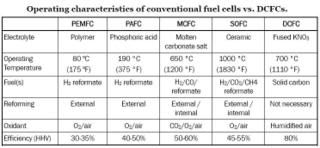
 DCFC's can use a large number of carbon-rich fuels, but organic waste and biomass are at the center of the attention because they are renewable and clean, but also because they can be turned into the purest carbon fuel. The overall process of producing electricity in a DCFC from biomass gains efficiency by its simplicity. It involves only two steps: (1) drying (and/or pyrolysis, or hydrothermal carbonization) to obtain char, and (2) feeding the resulting fuel directly to the DCFC. Drying and/or pyrolysis or conversion into char via hydrothermal carbonization is required to create a carbon-rich particulate solid that can be fed to the DCFC fuel cell to produce power:
DCFC's can use a large number of carbon-rich fuels, but organic waste and biomass are at the center of the attention because they are renewable and clean, but also because they can be turned into the purest carbon fuel. The overall process of producing electricity in a DCFC from biomass gains efficiency by its simplicity. It involves only two steps: (1) drying (and/or pyrolysis, or hydrothermal carbonization) to obtain char, and (2) feeding the resulting fuel directly to the DCFC. Drying and/or pyrolysis or conversion into char via hydrothermal carbonization is required to create a carbon-rich particulate solid that can be fed to the DCFC fuel cell to produce power: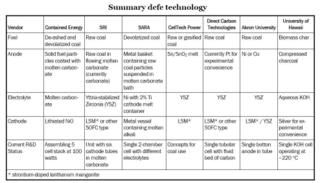
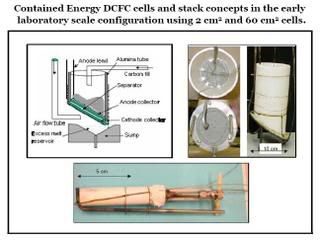
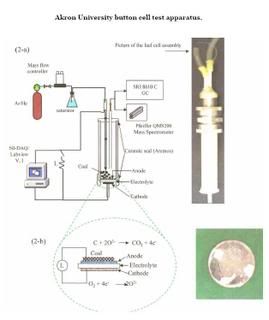
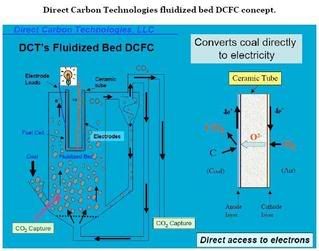
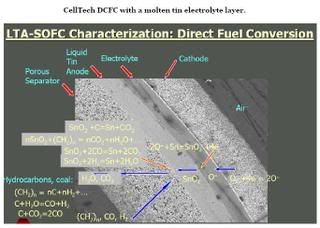
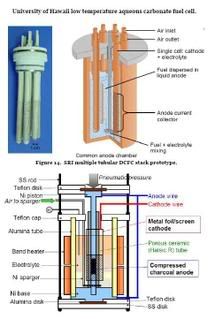
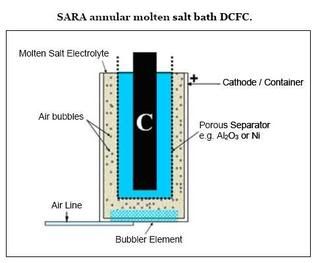
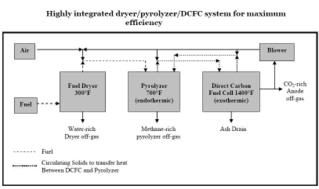

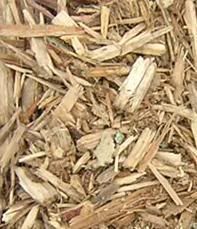 Georgia Power and Greenway Renewable Power LLC, an affiliate of bioenergy company Rollcast Energy Inc.,
Georgia Power and Greenway Renewable Power LLC, an affiliate of bioenergy company Rollcast Energy Inc., 







Tuesday, February 12, 2008
European Parliament ENVI Committee organises workshop on sustainability criteria for biofuels
European Parliament rapporteur MEP Dorette Corbey and shadow rapporteurs for the Fuel Quality Directive have decided that it is indeed worth the effort to enter into these first reading negotiations with the European Council. There is, however, one political issue that deserves full attention of the different committees, they feel: sustainability criteria for biofuels.
Recent scientific evidence suggests that the CO2 efficiency of some first generation biofuels is problematic, in particular if land use changes are taken into account (previous post). The vote in the Committee on Environment, Public Health and Food Safety (ENVI) approves sustainability criteria, including land use changes. Meanwhile the European Commission has presented its own proposal on renewable energies which contains sustainability criteria, although they are less stringent than the ones included in the ENVI-decision.
The European Parliament ENVI Committee, the TAUW Consulting and Engineering Company together with the EP's ENVI Committee Secretariat and the EP's Policy Department A will therefor be organising a workshop on "Sustainability criteria for biofuels".
The event is set to take place Tuesday 4 March 2008 in the European Parliament, Brussels. Participation in the workshop is free of charge and open to all, but requires registration beforehand. The programme looks as follows:
Part 1: The Institutional context
15:10 - Representative of the Slovenian Presidency
15:20 - Representative of the European Commission
Part 2: Panel of experts
General introduction - Technical aspects of sustainability criteria
15:30 - Greg Archer (LowCVP - Low Carbon Vehicle Partnership)
Criteria related to CO2 efficiency/saving and land use change
15:40 - Robert Edwards (Joint Research Centre, Italy, speaker to be confirmed)
15:50 - Bas Eickhout (MNP, Netherlands Environmental Assessment Agency)
16:00 - Debate: Questions and answers session
Criteria related to biodiversity and water
16:30 - Ms Berien Elbersen (Wageningen University and Research Center, Netherlands)
16:40 - Rothamsted Centre for Bio-energy and Climate Change, UK (to be confirmed)
16:50 - Debate: Questions and answers session
Criteria related to social issues
17:20 - Neil Judd (ProForest, UK)
17:30 - Debate: Questions and answers session
Part 3: Conclusions
18:00 - Closing remarks – Rapporteur MEP Ms Dorette CORBEY and Shadow Rapporteurs
Registration ends by Tuesday 26 February 2008. Interested parties that do not have a permanent entrance accreditation for the European Parliament should contact TAUW's organisers (address below) and provide them with your date of birth and nationality.
For further information and registration, please contact:
Jurgen Ooms
TAUW
P.O. Box 133
7400 AC Deventer
The Netherlands
Jurgen.Ooms [ at ] tauw.nl
Tel. +31 570 699 808
Fax +31 570 699 666
References:
EurActiv: The review of the EU's Fuel Quality Directive - Link Dossier.
Article continues
posted by Biopact team at 9:28 PM 0 comments links to this post
